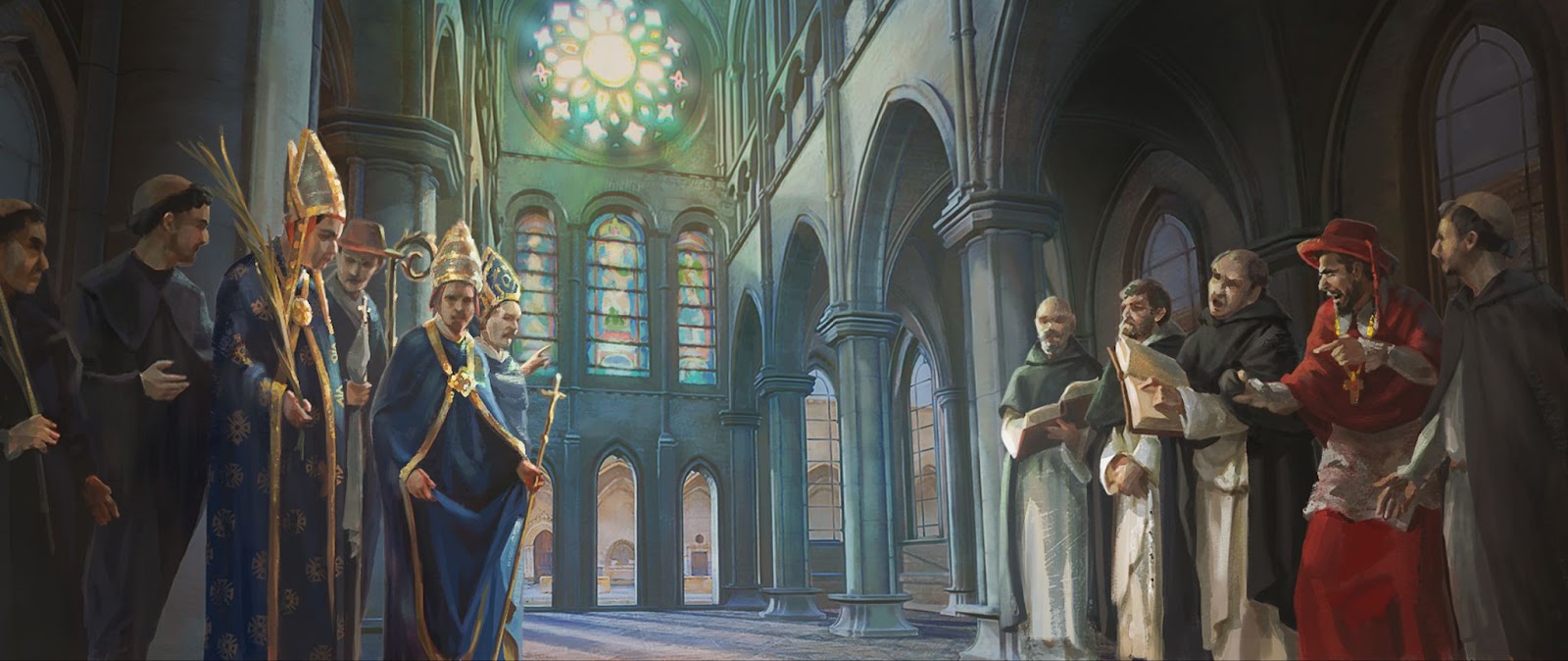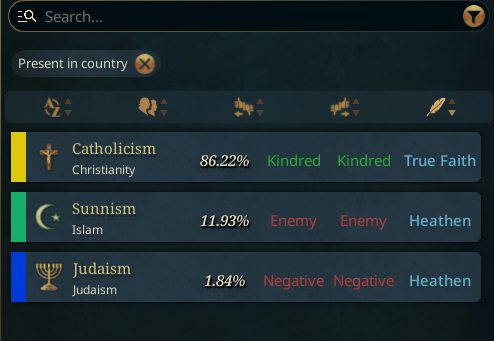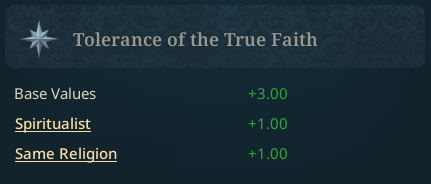@Pavía @Johan
Hello,
(Yes, this was prepared in advance)
Big eurasian nomad nerd here (I guess you’ll see me again for the horde dev diaries lol) and here are some (hopefully constructive) opinions regarding the portrayal of religion in the beautiful steppe.
Firstly and most importantly of all, I really think that « tengrism » should rather be named « altaic shamanism » (to distinguish it from "sibirian shamanism" which you decided to depict, which is... interesting) as it is non controversial and better reflects the historical reality and diversity of religious phenomena among altaic people.
The name « tengrism » corresponds to the modern, panturkic, revivalist movement spearheaded by not-so-frequentable turkish supremacists like Nihal Atsiz and para-f*scist groups like the Grey Wolves. Their connection to the idea of "tengrism" is abundant online. It was later used by central asian authors in the 1990s in a context of a search for national identity and independence and has since, unfortunately, pervaded popular discourse.
« Tengrism » is therefore loaded with heavy monotheistic bias/projection and ahistorical rigid dogmatism from all sides (including in the West) and its careful historical analysis does not hold up to scrutiny.
Where does « Tengri » come from ?
The first recorded use of the name « Tengri » by turko-mongol societies is the 8th century Orkhon inscription, found in present day Mongolia, using the Turkic runic script and chinese (it will be really important soon !). It details the Göktürk foundation myth and their extensive interactions with the chinese Tang empire.
The Orkhon inscriptions indeed prove the belief in « Tengri », but by the ruling Ashina elite only at best, and cannot be possibly considered as representative of the belief systems of all turko-mongol populations of that period.
In this context, the reference to « Tengri », or should I rather say « (Kök) Möngke Tengri/Eternal (Blue) Sky/Heaven » is made first and foremost in the context of legitimizing political authority, not in an exclusively religious doctrine/text. This is a tradition that will perdure in later turko-mongol societies, even after the conversion to Islam or Buddhism (M. Favereau, The Horde : How the Mongols changed the World, 2021).
Famous exemples are its mention as a foreword of virtually all imperial decrees/edicts of all the constituent parts of the Great Mongol State such as the Imperial Seal of the Great Mongols (internal politics, source 1) or Arghun Khan’s letter to King Philip IV of 1289 (foreign relations, source 2) . Here is also a great example of « Tengri » coexisting side by side with Muhammad from the Ilkhanid period: « in the might of the everlasting Heaven, in the support of prophet Muhammad », that could either be taken as religious syncretism or a separation of the political and the religious (source 3, big props to this guy btw, he does an excellent job at making primary sources accessible).
Consequently, Tengri should be apprehended as political concept first and foremost, as it is the source, divine yes, of ultimate political authority.
In that sense, the use of « Tengri » is much much closer to the political chinese concept of Ti’an (as in Mandate of Heaven) than anything else. And it makes perfect sense. They both relate to the big blue blob above our heads that is commonly translated as « Heaven », the impersonal will from which derives sovereignty. Eurasian nomadic societies such as the Xiongnu, Rouran, Göktürks, Xianbei and chinese elites not only all practiced well historically attested intermariage for centuries (heck the founder of the Göktürks himself, Bumin Khan, was married to a chinese princess), but they also actively participated in chinese politics by forming numerous northern polities during the so-called « Upheaval of the Five Barbarians » period and later (Northern Wei, Khitan-Liao, Jin are but famous exemples).
Considering that the Orkhon inscriptions, written in chinese, were made in a context of asserting turkic sovereingty from the Tang after centuries of cultural exchanges aforementioned above, explaining « Tengri » without having « Ti’an » in mind seems difficult. Some go further, even connecting the etymologies of « Tengri » and « Ti’an » (such as it can be read here : source 4) but I personally wouldn’t go as far, since I’m not a linguist.
Final nail in the coffin, the second direct primary source recording extensively the name « Tengri », written in turkic by a manicheist uyghur monk in a manicheist monastery using manicheist terminology in the 9-10th century is the oracle book Irk Bitig. And how does it start ? « I am Ten-si », a title that is definitely not turkic and that fellow sinologists will easily recognize, translated as « the Son of Heaven » (source 5).
The Orkhon inscription and Irk Bitig are both used by tengrist revivalists as the foundation of turkic mythology/tengrism without any context (nor any mention of chinese obviously). The entirely religious nature of the latter is uncontested, as it is exclusively an oracle book after all (and was found in a buddhist monastery anyway). But virtually all experts on the matter except one agree that it is either a manicheist text, either a buddhist one, either syncretism from both heavily inspired by contemporary tibetan oracle books (source 6).
Even Jean-Paul Roux, the dissenting opinion here, famous turkologist, still nonetheless argues (in the commentary of my own edition of William of Rubruck’s travel to Khan Möngke’s court, 1253-1255, source 7) that the position of « Tengri » as the supreme/central deity is extremely relative and follows periods of centralization of power under various steppe dynasties (such as the early Göktürks or Chinggisid Mongols since both later adopted Buddhism).
I kindly invite you to read again any translation of the Orkhon inscriptions on your own with Ti’an in mind if my argument is not convincing enough (here’s a link source 8).
What did the altaic populations believe in ?
The word « tengri » (I will not use a capital letter here to distinguish it from the political « Tengri ») is definitely present in some altaic religious expressions, such as the modern mongols. However, this term refers to a multitude of « minor natural spirits », as shamanism is animistic in nature, not a single, supreme, central deity. O. Purev and G. Purvee, Mongolian Shamanism, 2006, present the traditional 99 types of « tengri » typology following a north/south-east/west distinction, with which the shaman interacts through trance.
Evidently, due to the massive influence of the political « Tengri » and the fact that « tengger » litteraly means « sky » in mongolian, a spirit is associated with Heaven, is definitely worshipped and even granted proeminence. However, this is far far far from universal, and cannot possibly be granted the supreme, monotheistic-like status, used my modern tengrist revivalists.
But even if mongolian shamanism recognizes the naming "tengri", it does not matter. I have yet to come across a single academic source that talks about (mongolian) "tengrism" instead of "shamanism" that is not directly linked or refering to panturanist pseudoscience.
In his, little bit outdated, yet referential, book on the matter (Shamanism: Archaic Techniques of Ecstasy, 1951), M. Eliade, does a great job of presenting the existing huge diversity of creation myths, recorded through centuries of oral tradition, present in sibero-altaic populations, some of which completely ignore the « Eternal Blue Sky » both as a word (« tengri ») and as a concept (« Tengri »). They rather use other metaphors when speaking of supreme/creator gods such as divine animals (deers, eagles, ravens, etc) or world-tree figures.
What definitely unifies all these different religious expressions is the person of the shaman though, as well as ancestor worship (Rubruck’s testimony is a reference here, as the felt figurines used by the medieval mongols that he described later disappeared and were replaced with buddhist forms of worship).
For all the listed reasons, and due to the problematic political nature and origin of the modern tengrist reconstructionist movement, I think that the name « (altaic) shamanism » is more appropriate in game.
How to portray shamanism in game ?
I share M. Eliade’s opinion that altaic shamanism cannot be considered a religion in the traditional western acadamic sense. The term « religion » itself being heavily connoted with protestant scholarly bias (and applying it to altaic societies would therefore amount to a prime exemple of orientalism). This view is also shared by more recent scholarship under the de/post-colonial lens (such as this one, source 9).
Indeed, altaic shamanism has no centrally codified and accepted dogma (that would position « Tengri » as a supreme deity, apart from the zealous modern ethno-nationalist reconstruction I guess), no institutionalized clergy (or priestly class/estate) and no communal ceremonies of worship.
Firstly, there is an issue in representing the shamans as a separate estate/pop class and my opinion is that they simply should not, as it is already the case in EU4.
Indeed, the shaman is nor a priest, nor a member of any self-constituted and organized, independent clergy : as someone that it in contact with the spirits, he serves the double social function of an oracle and of spiritual-physical healer, which makes it difficult to represent as a unified and coherent « class » or estate.
Members of the mongolian aristocracy themselves can also have shamanic attributes : from Chinggis Khan’s supposed mystical powers as reported in the mongolian imperial historiography, frequent accusations of witchcraft to eliminate political rivals during succession crises (such as the case of Fatima and Töregene Khatun) and Khan Möngke famously being busy burning bones to make political decisions as reported by Rubruck.
In that sense, shamans belong more to the nobility/aristocracy estate than anything else (even more so since the function is often hereditary, as the shaman is literally possessed by the spirit(s) of one or multiple ancestors, which leads to many instances of local elites gatekeeping the shamanistic functions inside their families for generations as recorded by Eliade).
A good illustration is the figure of Teb Tengri from Juvani’s 13th century History of the World Conqueror. Even if, according to Juvani’s account (that is not mentioned in other sources), he blessed and granted the name/title « Chinggis Khan » to Temujin, it is wrong to see him as a high priest or any kind of resemblance to the Pope-Emperor relationship of medieval Europe.
Indeed, if he was able to do so, it was first and foremost due to the fact that he was Temujin’s step brother (as genealogy is THE major aspect of political legitimacy in steppe societies), not because he was a shaman.
His further elimination not only lead to a strengthening of the crown and serves as a cautionary tale for dissenting members of the (chinggisid) aristocracy but also clearly shows the inexistence of political power backed up by shamanistic spiritual beliefs. Within the framework of turco-mongol shamanistic traditions, the Khan does not need shaman intermediaries to legitimize his rule : he is already the physical embodiment of the will of Heaven himself (through his sülde for those that want to go deeper

).
Secondly, there is also an issue with linking the clergy/priestly estate in the game with shamans/pops belonging to that religion. Indeed, there has be no recorded attempt at mass proselytism by any shamanistic leaders nor any war waged in order to enlarge or protect the believers of that faith. Hell, there is hardly even a mention of any single, coherent, community of believers similar to the notions of church, ummah or sangha until nationalism enters the scene and shamanism is associated with nationality (source 10).
Therefore, a politically-motivated increase in numbers of that population (for exemple through the use of a missionary in EU4) was never actively sought and definitely never lead in return to an increase in political power for the shamans.
Other religions as tools for legitimacy
However, the Khans definitely relied on other religious clerics to increase their own political legitimacy. As an exemple, when asked by Rubruck how can the Khan tolerate so many different religious congregations in his capital, his guide answers that the Khan cares little for which religion is ultimately true and he invited them so that they all prey their own gods for the Khan’s longevity and the State’s welfare.
Therefore, steppe societies in game should have a clergy estate and it should, imo, rather represent the actually existing, hierarchically organized religious class of the different cults present in the steppe (christians, buddhist, muslims, taoists, etc) similar to the calculations of the dhimmi estate.
Indeed, not only these groups were granted actual concrete privileges such as tax exemptions, land grants and proeminent political advisorial positions (like the famous taoist Qiu Chuji, confucean Yelü Chucai or the buddhist monk Phags-Pa) but were effectively supported by the Mongol Khans in order to boost their own authority, which absolutely fits within the game proposed mechanics.
Bonus yet essential : portrayal of buddhism in the mongolian plateau
Accessorily, I hope that Project Caesar will not perpetuate the wrong assumption that buddhism was not present in Mongolia until the 17th century, and will represent ingame a sizeable community there at the start date
This outadated view is the result of deeply ingrained, misinformed, evolutionist views of eurasian history dating back from the 19th century (of which R. Grousset’s Empire of the Steppes, 1939, is the archetype) and that are still propagated by « pop » historians such as J. Diamond, N. Harrari, D. Graeber or even J. Weatherford.
According to this view, following the old civilization-barbarism paradigm, nomadic pastoral societies are fundamentally incapable of producing the surpluses required to build State structures and hereafter, settled monastic communities. Definitely check out the magistral work of the holy trinity C. Atwood, D. Sneath and L. Munkh-Erdene if you want to see how deep the rabbit hole goes and how absolutely wrong this is.
There is well attested archeological evidence of a continuous buddhist presence in the mongolian plateau since the Xiongnu era (also makes sense due to its position north of the Silk Road, the way through which buddhism spread to China).
For exemple, the Bugut inscription found in Western Mongolia, from the Göktürk era, written in sogdian and brahmi scripts (both liturgical buddhist scripts of that period) records Taspar Khan, 4th Khan of the Göktürks, (himself a buddhist convert according to chinese sources) and his patronage of the buddhist community (sangha) (source 11), which proves that conversion did not only concern the elites, but also the masses.
Rows of ruins of buddhist stupas (including a 14m high one !) were also found at the site of Ordu Baliq, the former Uyghur capital in the Orkhon valley (source 12). The construction of a big buddhist temple in Qaraqorum started during the reign of Ögedei Khan and was completed during Möngke’s era, as attested by both archeological evidence and contemporary testimonies (source 13).
Rubruck (him again !), perfectly able to recognize oriental forms of christianity such as nestorianism, even describe his hilariously confusing encounter with what he describes as a specific group of « misguided christians » for they « do not believe in God » yet « have monks, bishops (lama’s conic hats ?), worship icons of saints (bodhisattvas ?) and wear the sign of the cross (swastika ?) on their hands ». If the parallels are not enough, he calls them « tuins » from the mongolian « toyin », used to talk about buddhists exclusively (source 14).
My post is already long enough so I will not detail Khubilai Khan’s conversion to buddhism and its adoption as the State religion of the Great Yuan, but I will just point out that it definitely did not happen in a vaccuum, merely out of political pragmatism or whatever is often claimed. You can find more here : source 15.
After the retreat of the Chinggisid court to Mongolia in 1368, the Northern Yuan dynasty keeps thinking itself as a buddhist monarchy : it keeps both the buddhist phags pa script and buddhist institution of preceptor of the realm instituted by Khubilai Khan (my source here is a great yet unfortunately untranslated book, D. Méda’s Bouddhisme de Mongolie, 2016).
Therefore, the puzzling (for conventional historians at least) decision of Altan Khan to install/create the institution of the Dalai Lama in Tibet in the 16th century, is the result of the fact that he evolves in a political environment saturated with ideas of buddhist kingship and is attempting to replicate the model of the patron-client relationship established between Khubilai and Phags-pa.
Therefore, considering 1/ the continuous, historically attested presence of a buddhist community in Mongolia, 2/ the widespread use of buddhism as a tool for political legitimacy by Mongols in front of other Mongols, and 3/ the persistent promotion of it by generations of Chinggisid Khans since (at least) Ögedei on the territory of Mongolia itself, it is wrong to assume that, as it is too often claimed, « most Mongols ignored buddhism after Khubilai’s conversion and remained shamanist in their belief » or « The Mongols returned to shamanic traditions after the collapse of the Yuan dynasty in 1368. »
P.S. My apologies for Jürchen/Manchu enjoyers as my research did not extend (yet !) to them.
TLDR : Tengrism never existed, shamanism does. Hordes should have dhimmi-like estate instead of clergy. Buddhism should be present in significant numbers at game start in Mongolia.







